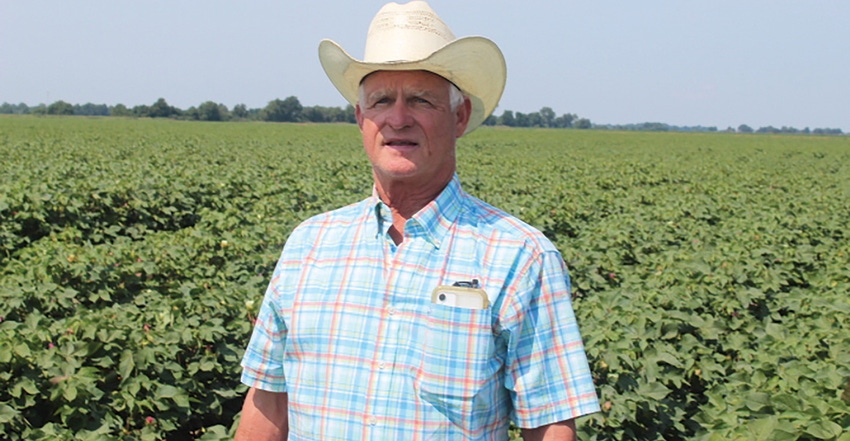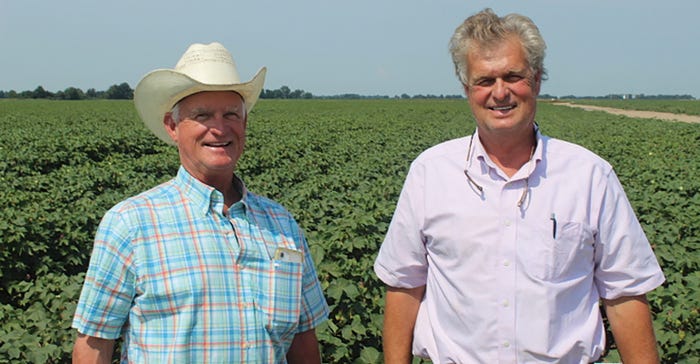November 1, 2021

2021 has been another challenging year for farmers in the Mid-south, but on a bright, sunny, but unusually cool day in August, Clarkedale, Ark., producer Sam Stuckey is feeling good about his cotton crop.
“This is one of the most uniform crops I’ve had,” said Stuckey, who expects to be finishing his 45th season with the harvest this fall. “Usually, when you have a crop this uniform that translates into good yields.”
Stuckey says he was fortunate to be able to plant on time, receive good rains and mostly favorable temperatures, but those who farm and work with him, including his brother, Fred Stuckey, and nephew, Michael East, and consultant, Chuck Farr, say there’s more to the story than good luck.
On the day Stuckey met with an editor at his farm office at 10 a.m. he had already checked seven center pivots to make sure they were running properly, and he planned to check six more after he finished posing for photos in a field where he’s growing several experimental varieties under Bayer Crop Science’s NPE or New Product Evaluator program.
“Sam has always been very hands-on with his cotton,” said Farr, who has been working for Stuckey and other farmers for more than 30 years. “He does a good job with all his crops, not just the cotton.”
Switching majors
After graduating from high school in Lepanto, Ark., in 1973, Stuckey was admitted to the engineering program at the University of Arkansas. But he decided to switch majors after meeting with Dean Glenn W. Hardy and other advisers in what became the Dale Bumpers College of Agriculture, Food and Life Sciences.
“I didn’t want to farm in Lepanto even though I did wind up farming there,” he said. “I wanted to come to Clarkedale where my mother’s side of the family had been farming. When that became possible, I transferred my major to ag and got an agronomy degree with a minor in ag business.
“I moved to Clarkedale from the University of Arkansas in Fayetteville in May of 1977,” he said. “We now farm in Crittenden County and Shelby County, Tenn., although the land is on the Arkansas side of the Mississippi River. And we farm in Poinsett and Mississippi Counties, where my father’s family farm was located.”
Sam Stuckey oversees the cotton, corn and soybeans that are grown around Clarkedale while brother, Fred, oversees the soybeans, rice and cotton grown around Lepanto in Poinsett and into Mississippi County. Nephew Michael East moves between the two.
“Sam is the cotton man,” says Fred. “He has always loved growing cotton. I kid him because I actually pick his cotton. That’s just one of those jobs I picked up years ago when I started farming.” (Besides Sam and Fred, their sister, Baylus East, Michael’s mother, is also involved in the operation.)

“Michael has been on the farm since 2009 and taken to it very well,” said Stuckey. “He’s our swing man, and he’s gaining a lot of experience in different areas of the farm.”
1980 drought
Sam Stuckey farmed through the disastrous drought in 1980 and others in 1981 and 1983. “The only reason my Dad and I survived was we had some equity in the land we farmed when some of our peers didn’t. We had almost no irrigation, and our crops suffered.”
Today, the majority of the acres on both sides of the operation are irrigated, which is one of the reasons Sam monitors the center pivot systems so closely. The operation also uses flexible irrigation tubing or polypipe on some of its more level ground.
“This has been a different year because it got very dry in June, and we had to start irrigating before we were finished with our fertility and crop protection chemicals,” he said. “July has been sort of a reverse month. It’s been friendly up until now. We had to do things out of order a bit because of the early irrigation.”
Making sure herbicides and insecticides are applied properly in his XtendFlex cotton is more than an economic and production issue for Stuckey, who serves on the Arkansas State Plant Board. “We can’t be off-label,” says Stuckey. “That was one of the commitments I made when I agreed to serve on the Plant Board.”
He is growing several NPE “Class of 22” experimental varieties, including some that contain the ThryvOn technology that incorporates resistance to tarnished plant bugs in the cotton plant. The technology could be a major breakthrough for farmers who rotate corn and cotton like Stuckey.
“I pretty much grow one year of cotton and one year of corn,” he says. “I’ve been in that rotation since 2014, and it’s raised my cotton yields by about 200 pounds. We do the same thing with rice and beans at Lepanto and here. Those are our two rotations, and it just seems to work for us.
“It also helps with weed control. We can fix a weed problem in cotton when we go to corn. We have different weed spectrums, and we have synergy from the different herbicide modes of action.”
Organic matter is improving. “We minimum-till our corn and use our old rows for corn and cotton, cotton and corn in the same place,” he said. “We do minimal disturbance of the soil to get it in good planting condition on top of the bed. We don’t have the dust storms that tear up the cotton. We don’t spend a lot of money on destroying the beds and building them back, either.”
Stuckey said he’s seen some good varieties come through his farm in the NPE program, which he has participated in since its beginning in 2008 with Monsanto and then Bayer Crop Science. “We keep up with the yield and the quality for them, and they seem to be pleased with the information they get from seeing it on my farm,” he said.
“I have the ThryvOn technology, and it’s pretty interesting. I didn’t spray it for thrips, and I sprayed for plant bugs once or twice. So, I saved one and possibly two thrips sprays and several plant bug sprays. We’ve gotten pretty far into the season to not have done more plant bug sprays.”
“We didn’t treat that part (the ThryvOn) of the field for thrips and treated the other part of the non-ThryvOn for thrips early,” said Farr. “In the early part of the season, it kind of stuck out like a sore thumb. It was impressive to look at it.
“We moved into the plant bug time of the year, and, in early season, pinhead matchhead square, when we were sweeping, we did treat the whole field. We had adults migrating in and out. It was not on nymphs, it was 100% on adults. We’re kind of surrounded there by corn. Last week, we treated the non-ThryvOn cotton based on nymphs, but not the ThryvOn.”
Farr said Stuckey’s work ethic has always been impressive. “Sam has always been a good cotton farmer and a good friend,” he noted. “He gets in there and plants as early as possible and takes care of his crop. I think he has a heckuva cotton crop this year.”
Stuckey says Midsouth farmers have to be adaptable. “I can count on one hand and not use all my fingers the number of easy years we’ve had. You have to manage risk as best you can. You can’t manage the markets other than to try to do a good job of marketing when you have an opportunity. And you can irrigate and try to make good decisions. Other than that, things can get out of your control quickly.”
About the Author(s)
You May Also Like






